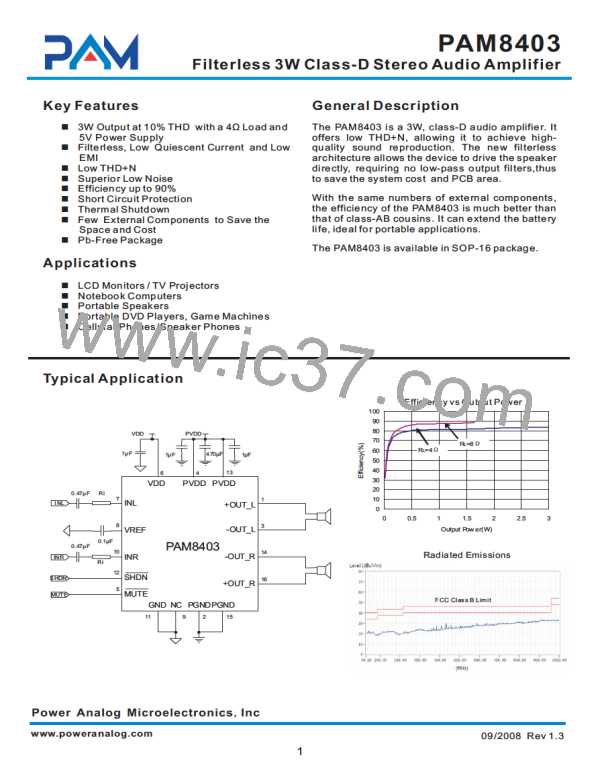PAM8403
Filterless 3W Class-D Stereo Audio Amplifier
Application Information
Maximum Gain
resistance (ESR) ceramic capacitor, typically
1.0μF, works best, placing it as close as possible
to the device VDD terminal. For filtering lower-
frequency noise signals, a large capacitor of
20μF (ceramic) or greater is recommended,
placing it near the audio power amplifier.
As shown in block diagram (page 2), the
PAM8403 has two internal amplifier stages. The
first stage's gain is externally configurable, while
the second stage's is internally fixed. The
closed-loop gain of the first stage is set by
selecting the ratio of Rf to Ri while the second
stage's gain is fixed at 2x.The output of amplifier
1 serves as the input to amplifier 2, thus the two
a m p l i f i e r s p r o d u c e s i g n a l s i d e n t i c a l i n
magnitude, but different in phase by 180°.
Consequently, the differential gain for the IC is
Input Capacitor (Ci)
Large input capacitors are both expensive and
space hungry for portable designs. Clearly, a
certain sized capacitor is needed to couple in low
frequencies without severe attenuation. But in
many cases the speakers used in portable
systems, whether internal or external, have little
ability to reproduce signals below 100Hz to
150Hz. Thus, using a large input capacitor may
not increase actual system performance. In this
case, input capacitor (Ci) and input resistance
(Ri) of the amplifier form a high-pass filter with
the corner frequency determined by equation
AVD=20*log [2*(Rf/Ri)]
The PAM8403 sets maximum Rf =142kΩ,
minimum Ri=18kΩ, so the maximum closed-gain
is 24dB.
Mute Operation
below,
1
2πR
fC=
The MUTE pin is an input for controlling the
output state of the PAM8403. A logic low on this
pin disables the outputs, and a logic high on this
pin enables the outputs. This pin may be used as
a quick disable or enable of the outputs without a
volume fade. Quiescent current is listed in the
electrical characteristic table. The MUTE pin can
be left floating due to the internal pull-up.
iC
i
In addition to system cost and size, click and pop
performance is affected by the size of the input
coupling capacitor, Ci. A larger input coupling
capacitor requires more charge to reach its
quiescent DC voltage (nominally 1/2 VDD). This
charge comes from the internal circuit via the
feedback and is apt to create pops upon device
enable. Thus, by minimizing the capacitor size
based on necessary low frequency response,
turn-on pops can be minimized.
Shutdown operation
In order to reduce power consumption while not
in use, the PAM8403 contains shutdown circuitry
to turn off the amplifier's bias circuitry. This
shutdown feature turns the amplifier off when
logic low is applied to the SHDN pin. By switching
the SHDN pin connected to GND, the PAM8403
supply current draw will be minimized in idle
mode. The SHDN pin can be left floating due to
the internal pull-up.
Analog Reference Bypass Capacitor (CBYP
)
The Analog Reference Bypass Capacitor (CBYP) is
the most critical capacitor and serves several
important functions. During start-up or recovery
from shutdown mode, CBYP determines the rate at
which the amplifier starts up. The second
function is to reduce noise caused by the power
supply coupling into the output drive signal. This
noise is from the internal analog reference to the
amplifier, which appears as degraded PSRR and
THD+N.
Power supply decoupling
The PAM8403 is a high performance CMOS
audio amplifier that requires adequate power
supply decoupling to ensure the output THD and
PSRR as low as possible. Power supply
decoupling affects low frequency response.
Optimum decoupling is achieved by using two
capacitors of different types targeting to different
types of noise on the power supply leads. For
higher frequency transients, spikes, or digital
hash on the line, a good low equivalent-series-
A ceramic bypass capacitor (CBYP) with values of
0.47μF to 1.0μF is recommended for the best
THD and noise performance. Increasing the
bypass capacitor reduces clicking and popping
noise from power on/off and entering and leaving
shutdown.
Power Analog Microelectronics,Inc
www.poweranalog.com
09/2008 Rev 1.3
9

 PAM [ POWER ANALOG MICOELECTRONICS ]
PAM [ POWER ANALOG MICOELECTRONICS ]